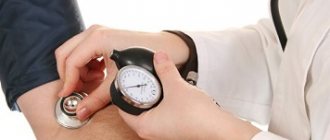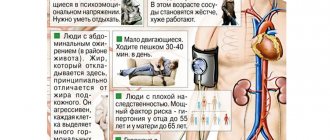Arterial hypertension (AH, arterial hypertension) is a pathological condition that leads to increased blood pressure, as a result of which the structure and function of the arteries and heart are disrupted.
Medical statistics claim that 30-40% of the world's inhabitants suffer from hypertension. Among people over 65 years of age, the disease is registered in 70%.
1
ABPM in the diagnosis of hypertension
2 Diagnosis of hypertension at MedicCity
3 Diagnosis of arterial hypertension
Hypertension significantly affects the quality of life: it causes attacks of headaches and dizziness, and affects performance. With long-term hypertension, irreversible changes occur in human organs and systems that threaten not only health, but also life itself.
Target organs for arterial hypertension:
- heart (left ventricular hypertrophy, heart failure, angina, myocardial infarction, etc.);
- brain (hypertensive encephalopathy, ischemic or hemorrhagic stroke, dementia);
- blood vessels (reduced arterial patency, aortic aneurysm);
- eyes (hemorrhages, retinal lesions, blindness);
- kidneys (renal failure).
1 ABPM for hypertension
2 ABPM for hypertension
3 ECHO-CG for hypertension
Blood pressure indicators for hypertension
The main manifestation of hypertension is a long-term and persistent increase in blood pressure (BP).
There are systolic (or upper) blood pressure, which shows the level of blood pressure at the moment the heart contracts, and diastolic (lower), which shows the level of blood pressure at the moment the heart relaxes.
Normal blood pressure levels are considered to be 120-134/80-84 mmHg, but data may vary due to emotional shocks, physical activity, changes in air temperature, etc. These fluctuations are normal; they reflect the body’s naturally programmed reaction to changes in living conditions. However, constantly elevated blood pressure in the absence of obvious reasons for this is a significant reason to take care of your health.
Arterial hypertension is indicated by a stable increase in blood pressure (systolic - above 140 mm Hg, diastolic - above 90 mm Hg when measured at a doctor’s appointment; 135/85 mm Hg and above - when measured independently) , confirmed by repeated measurements. To establish a diagnosis of arterial hypertension, two measurements with elevated blood pressure in the absence of physical and emotional stress are sufficient.
“Not a disease, but a symptom”: what is symptomatic arterial hypertension?
Hypertension is one of the most common “diseases of civilization.” Its leading manifestation is an increase in blood pressure. However, there is a group of diseases that are also accompanied by high blood pressure.
With Nina Ananyevna Polyntsova, cardiologist at Clinic Expert Voronezh, we are talking about symptomatic arterial hypertension.
— Nina Ananyevna, what is symptomatic arterial hypertension?
-This is an increase in blood pressure, which is not an independent disease, but a symptom of diseases of other organs. These are the organs involved in regulating blood pressure. Symptomatic hypertension is also called secondary hypertension.
Symptomatic arterial hypertension is an increase
blood pressure, which is not independent
disease, but a symptom of diseases of other organs
— Is symptomatic arterial hypertension reflected in ICD-10?
- Yes. It is designated by code I15.
I15.0 – renovascular increase in blood pressure;
I15.1 – arterial hypertension in other kidney diseases;
I15.2 – secondary hypertension in endocrine pathology;
I15.8 – all other diagnosed types of secondary hypertension.
— How common is symptomatic arterial hypertension?
— According to statistics, it accounts for 5-10% of all cases of increased blood pressure.
— What types of symptomatic arterial hypertension are known?
— There are many symptomatic arterial hypertension. There are about 70 diseases manifested by high blood pressure. Some of them are more common, while others the doctor encounters very rarely in his practice.
According to the domestic classification, symptomatic arterial hypertension is divided into renal (nephrogenic), endocrine, hemodynamic, neurogenic, and iatrogenic.
- Renal (nephrogenic). It is divided into two options: with damage to the kidney tissue and kidney vessels. The first group includes pathologies such as pyelonephritis, glomerulonephritis, polycystic kidney disease, kidney damage due to diabetes mellitus (diabetic nephropathy), urolithiasis and a number of others. Pathologies of the renal vessels include stenosis (narrowing) of the renal artery (particularly due to atherosclerosis), fibrovascular dysplasia, and renal artery vasculitis.
What is the cause of increased blood pressure in renal pathology? With the fact that when this organ is damaged, substances (in particular renin) are produced that cause an increase in blood pressure.
— Endocrine symptomatic arterial hypertension. They, in turn, are divided into several subgroups:
a) adrenal gland. This organ secretes a number of hormones, the increased production of which can also cause an increase in blood pressure. Pathologies include Cushing's syndrome, hyperaldosteronism, pheochromocytoma;
b) pituitary: Cushing's disease;
c) thyroid (related to the thyroid gland). An increase in blood pressure in this case is associated with a disease such as thyrotoxicosis;
d) menopause (due to a lack of female sex hormones). It should also be noted that in the age period during which menopause occurs, hypertension is statistically more common. Therefore, it is not always easy to quickly determine whether we are talking about hypertension or symptomatic arterial hypertension caused by menopause.
What happens to a woman’s body after 40 years? Read about age-related changes in women through the eyes of a gynecologist in our article
— Hemodynamic arterial hypertension. They are associated with damage to certain vessels and the valvular apparatus of the heart. Increased blood pressure is caused by poor circulation.
Among the diseases are coarctation (narrowing) of the aorta at a certain level, heart defects (aortic valve insufficiency, patent ductus arteriosus), complete transverse heart block (one of the types of arrhythmias - heart rhythm disturbances).
More information about arrhythmias can be found here
— Neurogenic arterial hypertension. They are associated with damage to the central nervous system. Occurs with encephalitis, after traumatic brain injury, with severe disturbances in the circulation of cerebrospinal fluid.
— Iatrogenic arterial hypertension. They are caused, in particular, by taking medications. Some examples of such medications: nasal vasoconstrictor drops; inhalers that relieve bronchospasm; glucocorticoids; non-steroidal anti-inflammatory drugs; contraceptives (with long-term use) and others.
— How do symptomatic arterial hypertension manifest itself?
- Signs can be varied. Conventionally, two groups of manifestations can be distinguished:
- increased blood pressure and associated symptoms - such as nonspecific headaches, dizziness, palpitations, etc.;
- symptoms of the underlying disease.
Symptomatic arterial hypertension is observed more often in young people (younger than 20-30 years), or suddenly develops in old age (after 55-60 years).
These hypertensions are characterized by a rapid onset, a crisis course, or an initially persistent increase in blood pressure. Medicines that lower blood pressure are ineffective. According to statistics, among treatment-resistant, aggressive hypertension, 20% are symptomatic arterial hypertension.
There are high numbers of both systolic (upper) and diastolic (lower) pressure. However, there is also isolated systolic hypertension, when the upper pressure is increased, and the lower pressure is either normal or even less than normal. For example, such isolated low diastolic pressure occurs with aortic valve insufficiency: the more severe the insufficiency, the lower the diastolic pressure (in this case, there is an increase in the so-called pulse pressure - the difference between systolic and diastolic).
— How can symptomatic arterial hypertension be detected?
— Diagnostics is based on data obtained during a detailed interview and examination of the patient, and the results of laboratory and instrumental research methods.
Usually, tests such as a general clinical blood test, urine test, some parameters of a biochemical blood test (in particular, glucose, creatinine, cholesterol, potassium), ECG, EchoCG (ultrasound of the heart), and ultrasound of the kidneys are always prescribed.
Depending on the specific manifestations of the underlying disease, appropriate additional examinations are prescribed. For example, renal arterial hypertension can be suspected by a history of kidney pathology, changes in blood tests, and urine tests. According to the doctor's decision, instrumental diagnostics are also used: ultrasound, CT, MRI of the kidneys, intravenous urography, kidney biopsy.
If, against the background of high blood pressure, the patient complains of severe muscle weakness, a tingling sensation, goosebumps, thirst, and the release of large amounts of urine, hyperaldosteronism can be suspected. With it, in addition to the potassium level, it is necessary to study the content of sodium, renin and aldosterone. Ultrasound, CT, and MRI are also performed to detect pathological changes in the adrenal gland.
If the patient has lost weight, is bothered by trembling in his hands, has a sparkle in his eyes, and has bulging eyes, then thyrotoxicosis can be suspected. In this case, an ultrasound examination of the thyroid gland is performed to determine the level of a number of hormones - in particular TSH (pituitary hormone), triiodothyronine (T3) and thyroxine (T4) (thyroid hormones).
Suspicion of hemodynamic arterial hypertension may arise when a systolic murmur is detected during listening (auscultation) of the precordial region. With coarctation of the aorta, the upper part of the human body is well developed, while the lower part is worse, this difference is visible to the eye. With aortic valve insufficiency, high pulse pressure is observed. Cardiac ultrasound and ECG are of great help in establishing and clarifying the diagnosis.
The range of necessary studies in each specific case is determined by the doctor.
— How is symptomatic arterial hypertension treated?
— All patients receive medications that lower blood pressure. Today there are several groups of such drugs. Their choice depends on the underlying disease against which arterial hypertension developed. In addition, treatment of the underlying disease itself is carried out, including, if indicated, surgical treatment (for example, removal of a tumor of the adrenal cortex). If the cause is eliminated, blood pressure may return to normal.
Patients with symptomatic arterial hypertension must be treated by a cardiologist, and in addition to him, a doctor who treats the underlying disease
— Who treats symptomatic arterial hypertension?
— Treatment of symptomatic hypertension is the responsibility of different specialists. Such patients must be treated by a cardiologist, and in addition to him, a doctor who treats the underlying disease. This could be a urologist, nephrologist, endocrinologist, or surgeons of various profiles.
You can make an appointment with a cardiologist and other specialists here
ATTENTION: the service is not available in all cities
Interviewed by Enver Aliyev
The editors recommend:
Speculation about hypertension
The Ultimate Guide to High Blood Pressure: Frequently Asked Questions
When is daily blood pressure monitoring prescribed?
For reference:
Polyntsova Nina Ananyevna
Graduate of the Faculty of General Medicine of the Voronezh State Medical Institute in 1979.
In 1980, she completed an internship in surgery, and in 1986, a clinical residency in therapy.
In 1990, she underwent professional retraining in cardiology.
Doctor of the highest category.
Currently, he is a cardiologist at Clinic Expert Voronezh. Receives at the address: Pushkinskaya St., 11.
Degrees of arterial hypertension
In modern cardiology, several classifications of arterial hypertension are used.
Classification by origin
Arterial hypertension can be an independent disease (hypertension). Or act as a sign of diseases of other organs, systems - endocrine glands (thyroid, adrenal glands), kidneys, heart, blood vessels. And also be the result of taking certain medications. In this case, we will talk about symptomatic (or secondary arterial hypertension).
The classification of hypertension according to blood pressure level, adopted by WHO, distinguishes three degrees of arterial hypertension:
1st degree (soft) - 140-159/90-99; 2nd degree (average) - 160-179/100-109; 3rd degree (severe) - 180/110 and above;
Isolated systolic hypertension is distinguished separately - SBP is above 180, DBP is below 90.
According to the degree of target organ damage, three stages of arterial hypertension are distinguished:
- at the first stage of arterial hypertension, an increase in blood pressure is not accompanied by changes in target organs;
- at the second stage, there is a persistent increase in blood pressure and organic changes in internal organs (however, without significant impairment of their functions). At this stage of the development of hypertension, signs of atherosclerotic damage to large vessels, narrowing of the retinal arteries, hypertrophy of the left ventricle of the heart may be detected; there is an increase in the level of creatinine in the blood and protein in the urine;
- at the third stage of arterial hypertension, a significant increase in blood pressure is associated with pathological changes in target organs and severe impairment of their functions (myocardial infarction, acute cerebrovascular accident, retinal hemorrhages, etc.).
1 Ultrasound of the heart for hypertension
2 ECG for hypertension
3 Diagnosis of hypertension at MedicCity
Publications in the media
Symptomatic arterial hypertension (AH, secondary arterial hypertension) is secondary hypertension that occurs as a result of damage to organs and systems that regulate blood pressure. Statistical data. 5–10% of all cases of hypertension (according to specialized clinics, using complex and expensive research methods, secondary hypertension can be detected in 30–35% of patients).
Etiology
• Kidney diseases •• Acute and chronic glomerulonephritis and pyelonephritis •• Obstructive nephropathy •• Polycystic kidney disease •• Systemic connective tissue diseases (SLE, systemic scleroderma, etc.) •• Systemic vasculitis •• Diabetic nephropathy •• Hydronephrosis •• Congenital renal hypoplasia •• Kidney injuries •• Renin-secreting tumors •• Primary salt retention (eg, Liddle's syndrome).
• Iatrogenic hypertension caused by taking drugs and exogenous substances •• Nasal drops and medications for the common cold containing adrenomimetic or sympathomimetic agents (for example, ephedrine, pseudoephedrine, phenylephrine) - an increase in blood pressure is possible •• Oral contraceptives containing estrogens - hypertension develops approximately in 5% of women (mechanisms: stimulation of the renin-angiotensin system and fluid retention) •• NSAIDs (indomethacin, etc.) cause hypertension as a result of suppression of the synthesis of Pg, which has a vasodilating effect, and also due to fluid retention •• TADs can cause an increase in blood pressure from -due to stimulation of the sympathetic nervous system •• GCs cause an increase in blood pressure due to an increase in vascular reactivity to angiotensin II and norepinephrine, as well as as a result of fluid retention.
• Endocrine diseases •• Acromegaly •• Hypothyroidism •• Hyperthyroidism •• Itsenko-Cushing syndrome •• Aldosteronism •• Congenital adrenal hyperplasia •• Pheochromocytoma •• Extra-adrenal chromaffinoma.
• Vascular diseases •• Coarctation of the aorta and its main branches •• Renal artery stenosis (vasorenal hypertension) •• Takayasu's disease.
• Systolic cardiovascular hypertension •• Aortic valve insufficiency •• Aortic sclerosis •• Severe bradycardia (III degree AV block) •• Arteriovenous fistulas •• Patent ductus arteriosus.
• Complications of pregnancy - see Arterial hypertension during pregnancy.
• Neurological diseases •• Increased ICP •• Brain tumors •• Encephalitis •• Respiratory acidosis •• Sleep apnea •• Paralysis of the limbs •• Guillain-Barre syndrome.
Clinical manifestations - see Arterial hypertension.
• Evidence of secondary hypertension •• Kidney disease, urinary tract infection, bacteriuria, hematuria, proteinuria •• Abuse of analgesics (damage to the renal parenchyma) •• Use of various drugs or substances: oral contraceptives, nasal drops, cocaine, NSAIDs •• Sweating, headaches, agitation (pheochromocytoma) •• Muscle weakness and tetany (aldosteronism).
• Physical examination •• Signs of endocrine diseases accompanied by hypertension: hypothyroidism, thyrotoxicosis, Itsenko-Cushing syndrome, pheochromocytoma, acromegaly •• Palpation of peripheral arteries, auscultation of vessels, heart, chest, abdomen to exclude diseases of the aorta and renovascular hypertension.
Research methods
• Mandatory methods •• OAM •• Determination of creatinine content in blood plasma •• Determination of potassium, sodium, glucose, cholesterol in blood plasma •• ECG.
• Additional methods •• Determination of triglycerides, HDL cholesterol, and uric acid in blood plasma •• Hb and Ht •• Urine culture •• X-ray examination •• EchoCG •• Determination of renin, angiotensin, aldosterone, corticosteroids, catecholamines •• Aortography and renography •• MRI/CT.
Treatment
• Hypertension in obesity •• Normalization of body weight •• Drugs of choice - calcium channel blockers, ACE inhibitors, a-blockers. The use of direct vasodilators (promote fluid retention) and diuretics (aggravate dyslipidemia) is not recommended.
• Drug hypertension •• Cancellation of the drug that caused hypertension •• If hypertension persists or the need to continue taking the drug, despite its side effects, - an antihypertensive drug •• For hypertension caused by drugs with sympathomimetic properties (for example, ephedrine, MAO inhibitors) - b-blockers •• For hypertension caused by oral contraceptives, drugs that stimulate the renin-angiotensin system, causing fluid retention in the body - ACE inhibitors and diuretics •• For hypertension associated with taking GCs - b-blockers, ACE inhibitors and /or diuretics •• If there is no effect, other secondary or essential hypertension should be excluded.
• “Alcoholic” hypertension •• First of all, you need to stop drinking alcohol (complete ban). In some cases, only this measure (not always easy to implement) can lead to normalization of blood pressure or its reduction •• Persons who are unable to completely give up alcohol are recommended to limit their intake to 21 alcoholic drinks per week for men and to 14 alcoholic drinks for women (one dose of alcohol corresponds to 8–10 g of pure alcohol, 0.5 l of beer or 1 glass of wine) •• One of the methods for monitoring the cessation of alcohol intake is to determine the dynamics of the content of g-glutamyl transpeptidase and the average volume of erythrocytes •• The drugs of choice are clonidine , ACE inhibitors, b-blockers and, possibly, blockers of slow dihydropyridine calcium channels. When taking drugs and alcohol, one should remember about their interactions (for example, the combination of clonidine + alcohol), withdrawal syndrome of substances taken (both drugs and alcohol), about which the patient must be warned •• With the development of post-alcohol withdrawal syndrome, accompanied by hypertension, β-blockers are considered one of the effective means (in the absence of contraindications).
• Hypertension in endocrine pathology •• In case of pheochromocytoma and primary hyperaldosteronism caused by an adenoma or carcinoma of the adrenal glands, the issue of surgical treatment should first be considered. If surgical treatment for pheochromocytoma is impossible for one reason or another, a-blockers (doxazosin, prazosin) are usually used. You should remember about the possibility of developing orthostatic arterial hypotension when using drugs in this group. The use of b-blockers (especially non-selective ones) is not recommended, since they can increase blood pressure due to blocking b2-adrenergic receptors. Indications for the use of beta-blockers are considered to be various arrhythmias that complicate the course of pheochromocytoma. In this case, preference should be given to selective b1-blockers in combination with α-blockers •• For primary hyperaldosteronism caused by adrenal hyperplasia, spironolactone is most often used at a dose of 100–400 mg/day. If it is necessary to enhance the antihypertensive effect, hydrochlorothiazide or α-blockers can be added. There is evidence of the effectiveness of amlodipine •• For hypothyroidism, drugs of all groups are prescribed, with the exception of b-blockers.
Abbreviations. AH - arterial hypertension.
ICD-10 • I15 Secondary hypertension
Signs of arterial hypertension
Often, hypertension has no symptoms at all other than persistent high blood pressure. At the same time, not every person constantly monitors their blood pressure levels, so arterial hypertension is often detected very late.
Contact your cardiologist immediately if you regularly notice signs of hypertension such as:
- headaches in the occipital region;
- dizziness;
- “flies”, a veil before the eyes;
- noise in ears;
- rapid and increased heartbeat;
- unpleasant tightness or pain in the chest;
- swelling of the arms and legs, puffiness of the face.
Hypertensive crisis is an emergency condition caused by an excessively high level of blood pressure (for example, up to 200/110 mm Hg and above), it is characterized by: headache, tremor, increased heart rate, chills, nausea, vomiting, sudden fear of death, anxiety , facial redness, swelling, sweating, vision distortion.
1 Ophthalmoscopy in the diagnosis of hypertension
2 Ophthalmoscopy for hypertension
3 Taking tests to diagnose hypertension
Materials
Arterial hypertension
What is blood pressure?
Blood pressure (BP) refers to the force with which blood presses against the walls of the arteries.
Arteries are blood vessels that carry blood from the heart to all organs. The level of blood pressure is determined by the work of the heart and the diameter of the blood vessels. The optimal blood pressure level is 120/80 mm Hg. Art. A blood pressure level below 130/85 mm Hg is considered normal. Art. High normal pressure is considered to be a pressure of 130-139/85-89 mmHg. Art.
Blood pressure is described by two numbers. The top number indicates the maximum pressure in the arteries during each contraction of the heart, that is, when the heart “works” and throws blood into the vascular bed - this is systolic blood pressure (SBP). The bottom number shows the lowest pressure in the arteries in the interval between heartbeats, i.e. when the heart “rests” and fills with blood before the next contraction is diastolic blood pressure (DBP).
Blood pressure may change throughout the day. Blood pressure is lower when you sleep or lie down, but it rises when you stand up. Physical activity, pain, anxiety or stress can cause a temporary rise in blood pressure, which is completely normal and has nothing to do with arterial hypertension.
What is arterial hypertension?
Hypertension means persistently elevated blood pressure. It is impossible to diagnose high blood pressure using one measurement. To make a diagnosis of hypertension, it is necessary that blood pressure is constantly above normal and that the doctor repeatedly (at least three times) during different visits notes elevated blood pressure numbers.
Arterial hypertension (AH) is a condition in which SBP is 140 mm. rt. Art. or more and/or DBP 90 mm. rt. Art. or more, and these values are obtained as a result of at least three measurements made at different times in a quiet environment without previous use of drugs that change blood pressure.
Increased blood pressure may be a consequence of another disease and then it will be called symptomatic arterial hypertension.
In hypertension, an increase in blood pressure is a symptom of the disease, not its consequence, and is caused by a violation of blood pressure regulation. This type of hypertension is the most common. It accounts for up to 95% of all types of arterial hypertension. The causes of essential hypertension are diverse, that is, many factors influence its occurrence.
Why is high blood pressure harmful to health?
With hypertension, clinical symptoms may be absent, and you may not be aware of high blood pressure for a long time. This is dangerous, because in the blood vessels, and then in the vital organs that they nourish - the heart, brain, kidneys, eyes - serious irreversible damage to their structure and function occurs. Therefore, it is necessary to regularly check your blood pressure at a doctor’s appointment or measure it yourself at home using special devices.
Even a slight increase in blood pressure, despite feeling well, is a reason to take it seriously, since hypertension leads to hypertensive crises, during which the risk of developing a cerebral stroke, myocardial infarction, cardiac asthma and pulmonary edema increases many times over.
High blood pressure promotes earlier and more active deposition of cholesterol (CH) in the form of plaques in the vessel wall, which accelerates the development of atherosclerosis in the arteries of the heart, brain, organs of vision, and kidneys. An atherosclerotic plaque narrows the lumen of the vessel and impedes blood flow, as a result of which the delivery of oxygen and nutrients to the organs decreases or even partially stops. This aggravates the course of hypertension and leads to the development of coronary heart disease (angina pectoris, myocardial infarction). With hypertension, the walls of the myocardium of the heart thicken (hypertrophy) and the risk of heart failure increases. In the future, in the absence of adequate treatment for hypertension, the walls of the heart may become thinner, their blood supply may be disrupted, shortness of breath, fatigue, and swelling in the legs may appear, i.e. heart failure may develop. Often hypertension leads to impaired renal function or aggravates the course of existing kidney diseases. In the elderly, elevated blood pressure contributes to memory impairment.
High blood pressure, despite the absence of any symptoms, has an adverse effect on target organs.
Types of symptomatic arterial hypertension
Renovascular hypertension
Renovascular (renal) hypertension occurs when the renal artery narrows, when an insufficient amount of blood enters the kidneys and the kidneys synthesize substances that increase blood pressure. Narrowing of the renal artery occurs with atherosclerosis of the abdominal part of the aorta, if the lumen of the renal artery is blocked, atherosclerosis of the renal artery itself with the formation of plaques narrowing its lumen, blockage of the artery by a thrombus, compression of the artery by a tumor or hematoma, trauma, inflammation of the wall of the renal artery. Congenital renal artery dysplasia is possible, when one or two arteries are narrowed from birth.
Renal arterial hypertension
Kidney diseases such as pyelonephritis, glomerulonephritis, and renal amyloidosis also lead to renal hypertension. The course of such arterial hypertension largely depends on the underlying disease, the speed and degree of blockage of the renal artery. Patients with renovascular arterial hypertension often feel well even with very high blood pressure numbers and do not lose their ability to work.
Renal hypertension usually responds poorly to antihypertensive drugs. During examination, patients may complain of lower back pain, after which an increase in blood pressure occurs. Sometimes a murmur is heard over the renal artery when listening to the abdomen. The x-ray may show different sizes of the kidneys. With excretory and isotope renography, the excretory function of one of the kidneys is reduced. Reliable evidence of the existence of renovascular hypertension in a patient is obtained from aortography and renal angiography (examination of the aorta and renal arteries using contrast agents). Treatment of renal arterial hypertension consists of treating the underlying disease.
Endocrine arterial hypertension
Endocrine arterial hypertension develops in diseases of the endocrine system: pheochromocytoma, primary hyperaldesteronism, Itsenko-Cushing syndrome, hyperparathyroidism (increased production of parathyroid hormones), hyperthyroidism.
Hemodynamic arterial hypertension.
Hemodynamic (mechanical) arterial hypertension occurs with coarctation of the aorta, aortic valve insufficiency, unclosed ductus arteriosus, and in the late stages of heart failure. Most often, hemodynamic arterial hypertension occurs with coarctation of the aorta, a congenital narrowing of the aorta. At the same time, in the vessels extending from the aorta above the site of narrowing, blood pressure is sharply increased, and in the vessels extending below the site of narrowing it is reduced.
A large difference between blood pressure in the upper and lower extremities is important for diagnosis. The diagnosis is finally established by contrast examination of the aorta. Treatment for high degrees of aortic stenosis is surgical.
Neurogenic arterial hypertension
Neurogenic arterial hypertension occurs in diseases of the nervous system. Brain tumors, strokes, injuries and increased intracranial pressure lead to increased blood pressure.
Drug-induced arterial hypertension
Drug-induced hypertension occurs when taking certain medications. These may be oral contraceptives, non-steroidal anti-inflammatory drugs, ephedrine, nervous system stimulants.
Risk factors for developing essential hypertension
Essential hypertension is the most common type of hypertension, although its cause is not always identified. However, in people with this type of hypertension, some characteristic relationships, so-called risk factors, have been identified.
Excess salt in food
Currently, scientists have reliably established that there is a close connection between the level of blood pressure and the amount of salt consumed daily by a person. Essential hypertension develops only in groups with high salt intake, more than 5.8 g per day.
In fact, in some cases, excessive salt intake may be an important risk factor. For example, excessive salt intake may increase the risk of hypertension in the elderly, Africans, obese people, genetic predisposition and kidney failure.
Sodium plays an important role in hypertension. About a third of cases of essential hypertension are associated with increased sodium intake. This is due to the fact that sodium is able to retain water in the body. Excess fluid in the bloodstream leads to increased blood pressure.
Heredity
The genetic factor is considered to be the main factor in the development of essential hypertension, although scientists have not yet discovered the genes responsible for the occurrence of this disease. Scientists are currently investigating genetic factors that affect the renin-angiotensin system, the same one that is involved in the synthesis of renin, a biologically active substance that increases blood pressure. It is located in the kidneys.
Approximately 30% of cases of essential hypertension are associated with genetic factors. If there are first-degree relatives (parents, grandparents, siblings), then the development of arterial hypertension is highly likely. The risk increases even more if two or more relatives have high blood pressure. Very rarely, a genetic disease of the adrenal glands can lead to hypertension.
Floor
Men are more predisposed to developing arterial hypertension, especially at the age of 35-55 years. However, after menopause, the risk increases significantly in women. The risk of developing hypertension increases in women during menopause. This is due to a hormonal imbalance in the body during this period and an exacerbation of nervous and emotional reactions. According to research, hypertension develops in 60% of cases in women during menopause. In the remaining 40%, blood pressure is also persistently elevated during menopause, but these changes disappear when the difficult time for women is left behind.
Age
This is also a fairly common risk factor. With age, there is an increase in the number of collagen fibers in the walls of blood vessels. As a result, the wall of the arteries thickens, they lose their elasticity, and the diameter of their lumen decreases.
High blood pressure most often develops in people over 35 years of age, and the older the person, the higher their blood pressure numbers usually are. In men aged 20-29 years, hypertension occurs in 9.4% of cases, and in men aged 40-49 years - already in 35% of cases. When they reach 60-69 years of age, this figure increases to 50%.
It should be taken into account that under the age of 40, men suffer from hypertension much more often than women. After 40 years, the ratio changes in the other direction. Although hypertension is called “the disease of the autumn of a person’s life,” today hypertension has become much younger: more and more often people who are not yet old are suffering from it.
Arterial pathology
In a large number of patients with essential hypertension: there is an increase in resistance (that is, loss of elasticity) of the smallest arteries - arterioles. The arterioles then become capillaries. Loss of elasticity of arterioles leads to increased blood pressure. However, the reason for this change in arterioles is unknown. It has been noted that such changes are typical for individuals with essential hypertension associated with genetic factors, physical inactivity, excessive salt intake and aging.
Renin
Renin is a biologically active substance produced by the juxtaglomerular apparatus of the kidneys. Its effect is associated with an increase in arterial tone, which causes an increase in blood pressure. Essential hypertension can be either high or low renin. For example, African Americans have low renin levels in essential hypertension, so diuretics are more effective in treating hypertension.
Stress and mental strain
Stress is understood as the presence of changes that occur in the body in response to extremely strong irritation. Stress is the body's response to strong environmental factors. Under stress, those parts of the central nervous system that ensure its interaction with the environment are included in the process. But most often, a disorder of the functions of the central nervous system develops as a result of prolonged mental stress, which also occurs in unfavorable conditions. With frequent mental trauma or negative stimuli, the stress hormone adrenaline causes the heart to beat faster, pumping a larger volume of blood per unit of time, as a result of which the pressure increases. If stress continues for a long time, then the constant load wears out the blood vessels, and the increase in blood pressure becomes chronic.
Smoking
The fact that smoking can cause the development of many diseases is so obvious that it does not require detailed consideration. Nicotine primarily affects the heart and blood vessels.
Obesity
A very common risk factor. Overweight people have higher blood pressure than thin people. Obese people are 5 times more likely to develop hypertension compared to those who are of normal weight. More than 85% of patients with arterial hypertension have a body mass index greater than > 25 kg/m2.
Diabetes
It has been established that diabetes mellitus is a reliable and significant risk factor for the development of atherosclerosis, hypertension and coronary heart disease.
Insulin is a hormone produced by the cells of the islets of Langerhans in the pancreas. It regulates blood glucose levels and promotes its passage into cells. In addition, this hormone has some vasodilating properties. Normally, insulin can stimulate sympathetic activity without causing an increase in blood pressure. However, in more severe cases, such as diabetes, stimulatory sympathetic activity may exceed the vasodilatory effect of insulin.
Snore
It has been noted that snoring may also be a risk for essential hypertension.
How to determine the severity of hypertension?
The severity of essential hypertension is determined by the degree of increase in blood pressure, target organ damage, and determination of the risk of cardiovascular complications.
Degrees of arterial hypertension
| Degree | I | II | III |
| Systolic blood pressure level, mm Hg. Art. | 140-159 | 160-179 | >180 |
| Diastolic blood pressure level, mm Hg. st | 90-99 | 100-109 | >110 |
If the SBP or DBP value falls into different categories, then the higher category is set.
The degree of hypertension is established in cases of newly diagnosed hypertension and in patients not receiving antihypertensive drugs. When determining risk, many factors are taken into account: gender, age, cholesterol levels in the blood, obesity, the presence of diseases with arterial hypertension in relatives, smoking, sedentary lifestyle, target organ damage.
Heart
Since the load on the heart muscle increases during arterial hypertension, compensatory hypertrophy (increase) in the thickness of the heart muscle of the left ventricle occurs. Left ventricular hypertrophy is considered a more important risk factor than diabetes, high blood cholesterol and smoking. In conditions of hypertrophy, the heart needs increased blood supply, and the reserve in arterial hypertension is reduced. Therefore, patients with hypertrophy of the wall of the left ventricle of the heart are more likely to develop myocardial infarction, heart failure, rhythm disturbances, or sudden coronary death.
Brain
Already in the early stages of arterial hypertension, blood supply to the brain may decrease. Headache, dizziness, decreased performance, and noise in the head appear. In the deep parts of the brain, with long-term arterial hypertension, small infarctions (lacunar) occur; due to impaired blood supply, the brain mass may decrease. This is manifested by intellectual decline, memory impairment, and in advanced cases, dementia (dementia). Kidneys There is a gradual sclerosis of the vessels and tissues of the kidneys. Their excretory function is impaired. The amount of urea metabolic products in the blood increases, and protein appears in the urine. Ultimately, chronic renal failure is possible. In arterial hypertension, almost all vessels are also affected. Depending on the presence of these risk factors, there are 1, 2, 3 or 4 degrees:
• Risk grade 1 (low risk) means that the patient has less than a 15% chance of having a cardiovascular event over the next 10 years.
• Risk level 2 (medium risk) assumes that the probability of cardiovascular complications in this patient is 15%-20% over the next 10 years
• Risk grade 3 (high risk) assumes that the likelihood of cardiovascular complications in this patient is 20-30% over the next 10 years
• Risk level 4 (very high risk) implies a probability of cardiovascular complications of more than 30% over the next 10 years.
Main symptoms of hypertension
Arterial hypertension often does not manifest itself in any way, which is why this disease has been called the “silent killer.” This is due to the fact that very often a person does not even suspect that he has high blood pressure, and only learns about it when complications occur, often fatal, such as a stroke or myocardial infarction.
Such asymptomatic manifestations of hypertension can last up to several years or even decades.
In some cases, manifestations of arterial hypertension include headaches, dizziness, shortness of breath and blurred vision.
It should be noted that the presence of symptoms of arterial hypertension is a reliable sign in comparison with its asymptomatic course, since the patient consults a doctor earlier, learns about his disease and begins treatment.
Headache. Therefore, it is not for nothing that doctors recommend checking your blood pressure when you have headaches; this diagnostic method is very simple, but at the same time informative.
Headache with increased blood pressure is mainly associated with vasoconstriction of the soft tissues of the head. The most characteristic symptom of arterial hypertension is a headache in the back of the head, as well as in the temples with a sensation of beating in them.
In addition, tinnitus may also be felt, which is associated with narrowing of the vessels of the hearing aid.
Double vision and blurred vision, such as pins and needles, are usually associated with vasoconstriction of the optic nerve, as well as the retina. This can sometimes even lead to temporary blindness. Vasoconstriction and impaired blood flow cause dysfunction of the retina with high blood pressure.
Nausea and vomiting during a hypertensive crisis are associated with increased intracranial pressure.
Shortness of breath may indicate ischemic events in the heart when there is a disturbance in blood flow in the coronary arteries.
In some cases, with arterial hypertension, a hypertensive crisis (or, as they say, hypertensive crisis) may occur. This is a condition in which there is a sharp increase in blood pressure, most often in combination with neurological manifestations in the form of severe headache, dizziness, double vision.
In addition, during a crisis, nausea and even vomiting may occur. Pain in the chest may also be observed, which is associated with ischemic phenomena in the coronary arteries (remember that when blood pressure increases, the arteries narrow).
The appearance of such a patient may be characteristic, with redness of the skin, and emotional agitation is often observed.
Methods for diagnosing hypertension
Diagnostic methods that allow you to determine the presence of arterial hypertension in a person are:
Blood pressure is measured using a special device - a tonometer, which is a combination of a sphygmomanometer and a phonendoscope.
Before measuring blood pressure (BP), you should not smoke or drink tea or coffee for 30 minutes, and you must rest for 5 minutes. The room should be quiet and warm.
The hand selected for measuring blood pressure must be relaxed and freed from clothing. This arm should be free of arteriovenous fistulas for dialysis, brachial artery incision scars, and lymphedema that may result from axillary lymph node removal or radiation therapy.
If you have not yet felt the pulse on the radial artery, then do so to make sure that it is not changed. Position your arm so that the brachial artery (in the elbow area) is at the level of the heart (fourth intercostal space at the edge of the sternum).
Position the cuff bladder over the brachial artery. The lower part of the cuff should be located 2.5 cm above the elbow. Attach the cuff so that it fits snugly around your shoulder. The arm must be slightly bent at the elbow joint.
To determine how high to raise the cuff pressure, first assess your systolic blood pressure. While monitoring the radial pulse with one finger, quickly inflate the cuff until the radial pulse disappears.
Note the pressure gauge readings and add another 30 mmHg. This method is used to ensure that too high pressure in the cuff during further inflation does not cause discomfort in the patient. This also avoids the error caused by the appearance of an auscultatory gap - a silent interval between systolic and diastolic blood pressure.
Quickly release all the air from the cuff and wait 15-30 seconds.
Place the stethoscope over the brachial artery. Quickly inflate the cuff to the previously determined level, and then slowly deflate the air at a rate of approximately 2-3 mmHg. in 1 second. Note the level at which you heard the sound of at least two consecutive contractions. This value corresponds to systolic blood pressure.
Continue decreasing the pressure in the cuff until the sound fades and disappears. To make sure that the sounds have really disappeared, continue listening until the pressure drops another 10-20 mmHg.
Then quickly release all the air from the cuff until the pressure drops to zero. The vanishing point, which is just a few millimeters of mercury below the fading point, provides the most accurate estimate of diastolic blood pressure in adults.
For some people, the muting point and the vanishing point are quite far apart. If the difference is more than 10 mmHg. Art., write down both values (for example, 150/80/68 mmHg).
Round systolic and diastolic pressure values within 2 mmHg. Wait 2 minutes. and then repeat.
Calculate the average. If the first two readings from the device differ by more than 5 mmHg, you need to measure your blood pressure again.
Avoid inflating the cuff with slow, repetitive movements, as the resulting venous congestion may cause incorrect readings.
It is worth noting that in a family where there is a patient with arterial hypertension, it is advisable to always have a device for measuring blood pressure; it is necessary that one of the relatives knows how to use it.
The patient himself can also measure his own blood pressure. In addition, there are currently special electronic devices on the market that measure blood pressure, pulse rate, and also allow you to enter blood pressure readings into the device’s memory.
Normal blood pressure limits for an adult are 110-139/70-89 mmHg.
Diagnosis of arterial hypertension also involves interviewing the patient with a doctor. The doctor asks the patient what diseases he previously suffered from or is currently suffering from.
An assessment of risk factors is carried out (smoking, high cholesterol, diabetes mellitus), as well as hereditary history, i.e., whether the patient’s parents, grandparents and other close relatives suffered from arterial hypertension.
A physical examination of the patient includes, first of all, examination of the heart using a phonendoscope. This method allows you to detect the presence of heart murmurs, changes in characteristic tones (increase or, conversely, weakening), as well as the appearance of uncharacteristic sounds. These data, first of all, indicate changes occurring in the heart tissue due to increased blood pressure, as well as the presence of defects.
An electrocardiogram (ECG) is a method that allows you to record changes in the electrical potentials of the heart over time on a special tape. This is an indispensable method for diagnosing, first of all, various heart rhythm disorders. In addition, the ECG allows us to determine the so-called hypertrophy of the left ventricular wall, which is characteristic of arterial hypertension.
Echocardiography (ultrasound examination of the heart) - allows you to determine the presence of defects in the structure of the heart, changes in the thickness of its walls and the condition of the valves.
Arteriography , including aortography, is an x-ray method for studying the condition of arterial walls and their lumen. This method allows you to detect the presence of atheromatous plaques in the wall of the coronary arteries (coronary angiography), the presence of coarctation of the aorta (congenital narrowing of the aorta in a certain area), etc.
Dopplerography is an ultrasound method for diagnosing the state of blood flow in vessels, both in arteries and veins. In case of arterial hypertension, first of all, the doctor is interested in the condition of the carotid arteries and cerebral arteries. Ultrasound is used for this widespread purpose, since it is absolutely safe to use and is not characterized by complications.
Biochemical blood tests are also used in the diagnosis of arterial hypertension. First of all, the level of cholesterol, triglycerides and low- and very low-density lipoproteins is determined, as they are an indicator of susceptibility to atherosclerosis. In addition, blood glucose levels are determined.
Study of the condition of the kidneys , for which methods such as a general urine test, a biochemical blood test (for creatinine and urea levels), as well as ultrasound of the kidneys and its vessels are used. Ultrasound of the thyroid gland and blood test for thyroid hormones. These research methods help to identify the role of the thyroid gland in the occurrence of high blood pressure.
It is possible that the list of studies offered to you will be different. This is natural. Your doctor will prescribe the necessary examination based on the characteristics of your body and the course of your arterial hypertension.
Reasons for the development of arterial hypertension
The exact cause of the development of hypertension has not yet been established, however, a clear relationship has been identified between hypertension and the following factors:
- Exposure to stress;
- hereditary predisposition;
- age;
- gender (AH is more common in men);
- abuse of table salt;
- smoking and alcohol;
- endocrine disorders;
- excess body weight;
- physical inactivity;
- kidney diseases;
- increased adrenaline levels;
Complications of arterial hypertension
Under conditions of constantly elevated blood pressure, the walls of blood vessels thicken and lose their ability to relax, which prevents normal blood supply and saturation of tissues and organs with oxygen and nutrients. Various serious complications arise, including the following:
- Hypertensive crisis;
- myocardial infarction;
- stroke;
- angina pectoris;
- heart failure;
- cardiac ischemia;
- chronic renal failure;
- retinopathy;
- atherosclerosis, etc.









